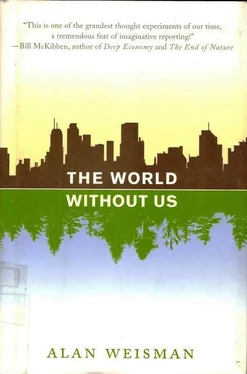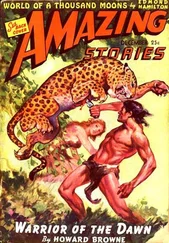Echevers shudders at the thought, because he’s seen how the Chagres reacts to rain: “Like a zoo animal that has never accepted its cage. The water loses control. If it was allowed to rise, it would top the dam.”
He stops to watch a pickup truck roll across the raised roadway that runs along the top of the dam. “If no one were here to open the floodgates, the lake would fill up with branches, tree trunks, and garbage, and at some point all that stuff would hit the dam and take the road with it.”
Cuevas, his quiet colleague, has been mentally calculating. “The head of the river would be huge when it goes over the top. Like a waterfall, it would erode away the river bottom in front of the dam. One really big flood could collapse the dam.”
Even if that never happened, they agree, eventually the spillway gates would rust away. “At that point,” says Echevers, “a 20-foot head of water would break free. Drastically.”
They look down at the lake where, 20 feet below, an eight-foot alligator floats motionless in the dam’s shadow, then streaks through the teal blue water as an unlucky terrapin surfaces. Madden Dam’s concrete wedge looks too solid to go anywhere. Yet one rainy day, it will likely flop over.
“Even if it survives,” says Echevers, “with no one here the Chagres will fill the lake with sediment. At that point, the dam won’t matter.”
In a chain-link compound where Panama City now spills into the former Canal Zone, Port Captain Bill Huff sits in jeans and a golf shirt before a wall of maps and monitors, guiding evening traffic through the Canal. A U.S. citizen born and raised here—his grandfather, a Canal Zone shipping agent, arrived in the 1920s—he moved to Florida after sovereignty over the Canal passed from the United States to Panama as the clock ticked off the first second of the new millennium. But his 30 years of experience were still in demand, and, now in the employ of Panama, he returns every few months to take a shift.
He switches a screen to a view of Lake Gatun’s dam, a low mound of earth 100 feet wide. Its submerged base is 20 times thicker. To the casual observer, there’s not much to see. But someone has to be looking all the time.
“There are springs underneath the dam. A couple of small ones have pierced through. If water runs clear, no problem. Clear water means it’s coming up through the bedrock.” Huff pushes back in his chair and rubs the dark beard circling his chin. “But if water starts bringing dirt with it, then the dam is doomed. In just a matter of hours.”
It’s hard to imagine. Gatun Dam has a 1,200-foot-thick, theoretically impermeable central core of rock and gravel cemented with liquid clays that are known as fines, sluiced up from the dredged channel below and tamped between two buried rock walls.
“The fines hold the gravel and everything together. They’re what starts coming out first. Then the gravel follows, and the dam loses its adhesion.”
He opens a long drawer in an old pine desk and pulls out a map tube. Unrolling a yellowed, laminated chart of the isthmus, he points to Gatun Dam, just six miles from the Caribbean. On the ground, it’s an impressive mile-and-a-half long, but on the map it’s clearly just a narrow gap compared to the tremendous expanse of water dammed behind it.
The hydrologists Cuevas and Echevers are right, he says. “If not during the first rainy season, within just a few years it would be the end of Madden Dam. That lake would all come pouring down into Gatun Lake.”
Gatun Lake would then start spilling over the locks on both sides, toward the Atlantic and the Pacific. For a while a casual observer might not notice much, “except maybe unkept grass.” The Canal’s prim landscaping, still maintained to American military standards, would start to turn lush. But before any palms or figs moved in, a flood would take over.
“Big surges of water would sluice around the locks and scour bypasses into the dirt. Once one of the lock walls started to tumble, that would be the end. All of Gatun Lake could spill.” He pauses. “That is, if it hadn’t already emptied into the Caribbean. After 20 years with no maintenance, I don’t see earthen dams left. Especially Gatun.”
At that point, the liberated Chagres River, which drove many French and American engineers crazy and thousands of laborers to their death, would seek its old channel to the sea. With the dams gone, the lakes empty, and the river again headed east, the Pacific side of the Panama Canal would dry up, and the Americas would be reunited.
The last time that happened, 3 million years ago, one of the greatest biological interchanges in Earth’s history commenced as North and South American land species began to travel the Central American isthmus, which now joined them.
Until then, the two landmasses had been separated since the supercontinent of Pangea began to break up about 200 million years earlier. During that time, the two separate Americas had embarked on enormously different evolutionary experiments. Like Australia, South America developed a menagerie of marsupial mammals, ranging from sloths to even a lion that carried its young in a pouch. In North America, a more efficient, ultimately triumphant placental path emerged.
This most recent man-made separation has existed for little more than a century—not enough time for any meaningful species evolution, and a canal barely wide enough for two ships to pass each other has hardly been much of a barrier. Still, speculates Bill Huff, until roots work their way into the cracks in the huge, empty concrete boxes that once held ocean-going vessels and finally shatter them, for a few centuries they will be rain-catch holes prowled by panthers and jaguars, as regenerating tapir, white-tailed deer, and anteaters come to drink.
Even longer than those boxes, for a while a big man-made, V-shaped gouge would remain, marking the place where humans undertook, in the words of Theodore Roosevelt after he went to Panama in 1906 to see for himself, “the greatest engineering feat of the ages. The effect of their work,” he added, “will be felt while our civilization lasts.”
If we disappeared, the words of this larger-than-life American president, who founded a national park system and institutionalized North American imperialism, would prove prophetic. Yet long after the walls of the Culebra Cut cave in, one last larger-than-life monument to Roosevelt’s grand vision for the Americas will remain.

IN 1923, SCULPTOR Gutzon Borglum was commissioned to immortalize the greatest American presidents in portraits every bit as imposing as that long-vanished wonder, the Colossus of Rhodes. His canvas was an entire South Dakota mountainside. Along with George Washington, father of the country; Thomas Jefferson, drafter of its Declaration of Independence and Bill of Rights; and Abraham Lincoln, the emancipator and reuniter, Borglum insisted on portraying Theodore Roosevelt, who joined the seas.
The site he selected for what qualifies as the United States’ national magnum opus, Mount Rushmore, is a 5,725-foot uplift composed of fine-grained Precambrian granite. When Borglum died in 1941 of a brain hemorrhage, he’d barely begun work on the presidential torsos. But the faces were all indelibly carved in stone; he lived to see the visage of his personal hero, Teddy Roosevelt, officially dedicated in 1939.
He’d even rendered Roosevelt’s trademark pince-nez in rock—a rock formed 1.5 billion years ago, among the most resistant on the continent. According to geologists, Mount Rushmore’s granite erodes only one inch every 10,000 years. At that rate, barring asteroid collision or a particularly violent earthquake in this seismically stable center of the continent, at least vestiges of Roosevelt’s 60-foot likeness, memorializing his Canal, will be around for the next 7.2 million years.
Читать дальше












